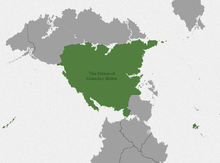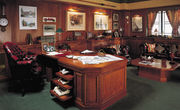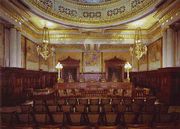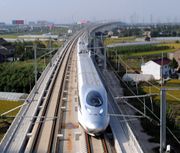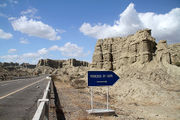Gilead
| This page is a work in progress by its author(s) and should not be considered final. |
| Union of Gileadan States | ||||||
|---|---|---|---|---|---|---|
|
||||||
| Motto: "Omnes Diligunt" (Latin) "Love All/One Love" |
||||||
| Anthem: Cusp of Glory (Latin) "Cusp of Glory" |
||||||
| Region | The Supreme Union | |||||
| Capital and largest city | Genoa, Cielo | |||||
| Official languages | English | |||||
| Recognised national languages | English, | |||||
| Ethnic groups | 92.7% Gileadan 3.3% Victoriumite, 2.4% Tantaloonian, 1.4%Izalithian, 0.2% Other |
|||||
| Demonym | Gileadan | |||||
| Government | Federal Republic | |||||
| - | President of the Union of Gileadan States | Gregory Romulus Austin | ||||
| Legislature | Congress of the UGS | |||||
| - | Upper house | Senate | ||||
| - | Lower house | General Assembly | ||||
| Established According to the National Archives | ||||||
| - | Gileadan Confederation | May 8, 1736 - December 27, 1749 | ||||
| - | Empire of Cielo | October 14, 1781 - March 6, 1857 | ||||
| - | Gileadan Unified Trade Zone | September 15, 1866 - Ongoing | ||||
| - | Union of Gileadan States | February 4, 1896 - Ongoing | ||||
| Area | ||||||
| - | Total | 13,433,228 km2 (2nd) 5,186,598 sq mi |
||||
| - | Water (%) | 3.5% | ||||
| Population | ||||||
| - | 2014 estimate | 351,536,782 (3rd) | ||||
| - | 2013 census | 337,536,782 | ||||
| - | Density | TBA/km2 (TBA) TBA/sq mi |
||||
| GDP (PPP) | 2012 estimate | |||||
| - | Total | Q$ 15.7 Trillion | ||||
| - | Per capita | Q$ 44661.04 (4) | ||||
| GDP (nominal) | 3 estimate | |||||
| - | Total | Q$ 15.7 Trillion | ||||
| - | Per capita | Q$ 44661.04 | ||||
| Gini (2014) | 45.0 medium |
|||||
| HDI (2014) | 0.946 very high · 3 |
|||||
| Currency | Quopes ((Q) (Q$) (GQ)) |
|||||
| Time zone | GED, GMT, GWD (UTC-7 to -10) | |||||
| - | Summer (DST) | SKST (UTC-6 to -10) | ||||
| Drives on the | right | |||||
| Calling code | +1 | |||||
| Internet TLD | .gil | |||||
| 1. | This information is subject to change. | |||||
Gilead, officially the Union of Gileadan States, is a massive federal republic on the North Gileadan continent. The federal government imposes a strong, overarching authority over the member-states on issues essential to the preservation of the Union while allowing for the States to uphold their own unique cultures.
There are currently 33 states in the Union, of which 3 are special territories. All states are subject to the Union Government which consists of the Supreme Court, the Congress, and the President.
Provinces and other subordinate levels of authority are allowed to administrate minor, localized issues and services such as sanitation, law enforcement, and municipal transit services.
Contents
Etymology
Gilead derives from Hebraic words. 'Gil' may be known to mean 'joy, and 'ad' may be known to mean 'forever'. So, Gilead may literally translate to 'Joy Forever' or 'Eternal Joy' which many believe to be how some of the first explorers of the continent viewed the natural beauty and seclusion of the continent.
Government
The current government system is derived from the former government of the Empire of Cielo. It retains a bi-cameral congressional system, yet replaced the House of Ministers with the more traditional Senate. It also instituted segregation of Judicial and Legislative branch, their combination being popular during the imperial era of Cielo.
Executive
This branch is headed by His Excellency, President Gregory Romulus Austin. The President appoints Ministers, traditionally one per ministry, to head them. They hold great authority over their ministries, only subjacent to the President, or restriction set by congressional legislation. Ministers hold the power to appoint or remove officials from office below their rank in their respective ministries. A minister's order is only be rendered null and void if overturned/overrode by the President or declared illegal by the Supreme Court.
The Ministers form the Council of Ministers, also known as the Ministerial Senate.
The President and the state Governors comprise the Executive Gileadan Assembly which congresses twice a year: once on January 31, then on July 1st (if either date falls on the Sabbath, the date is moved one day up).
There is no line of succession within the Presidential cabinet unlike in most states. If a presidential term is terminated by the termination of life rather than the completion of a normal term, a new President is elected by the Presidential Electorate, a joint assembly of the Ministers and the state Governors. The Presidential Electorate also elects a new president upon the termination of office by impeachment. The Congress has authority to impeach the President with the ascent of the Grand Court.
State Governors are directly elected by the citizens of their respective states.
| States | Governors |
|---|---|
| Ace | Michael Folsom |
| Bard | Cliff Willey |
| Cielo | Timothy Barge |
| Cirdo | Rex Hoyle |
| Congela | Len Archibald |
| Cragon | Mauricio Galvin |
| Delasus | Michel Workman |
| Devinaria | Peter Gardiner |
| Dolceta | Cory Brock |
| Emande | Jeffrey Garris |
| Evot | Lenard Hutchins |
| Fiermet | Joaquin Grisham |
| Friona | Eliot Grover |
| Fumer | Benjamin Cornell |
| Gardo | Ultric Bonner |
| Jefar | Gonzalo Hartman |
| Kofor | Ryan Everett |
| Lugan | Andrew Hoang |
| Meta | Tyren Smallwood |
| Monci | Shane Perdue |
| Oheron | Garry Redmond |
| Ormondo | Alvaro Khan |
| Piensole | Josue Kenyon |
| Potun | Neal Weed |
| Sardam | Graig Perkins |
| Solterra | Elwood Siler |
| St.Edward | Pete Silvo |
| Teatro | Chang Jacobsen |
| Yolktaw | Harland Levin |
| Zefa | Esteban Whitehead |
| Ministries | Minister | Function |
|---|---|---|
| Ministry of Agriculture | Hon. Frank Williams | Dedicated to maintaining excellence in agricultural ability and product. |
| Ministry of Commerce | Hon. Steven Sharp | Dedicated to commercial growth, development, and stability. |
| Ministry of Education | Hon. Richard Sanders | Dedication to the progression and public availability of standard education for all citizens. |
| Ministry of Energy | Hon. Quamar Santana | Dedicated to maintaining efficient, environmentally friendly, and affordable energy for public and private use. |
| Ministry of the Environment | Hon. Jacob McKinney | Dedicated to the protection, maintenance and development of the natural environment and the ecosystem. |
| Ministry of Foreign Affairs | Hon. Addison Banks | Dedicated to managing the foreign relations and actions for the best possible outcomes. |
| Ministry of the HMAF | Hon., Gen. Ethan Landry | Dedicated to defending the Union and asserting its power & influence. |
| Ministry of Human Health | Hon. Isaac Nostrum | Dedicated to preservation of human health within the provincial and any dependencies. |
| Ministry of Human Welfare | Hon. Gerald Waller | Dedicated to supplying every citizen with the necessary essentials to live an average life. |
| Ministry of Infrastructure | Hon. Robert Turner | Dedicated to preserving and continuing to progress the infrastructure. |
| Ministry of Intelligence | Hon. Hugo Lagos | Dedicated to preserving and continuing to progress Gilead's infrastructure. |
| Ministry of the Interior | Hon. Jordan Pavelski | Dedicated to interprovincial stability in all branches of government. |
| Ministry of Justice (also Chief Justice of the Grand Court) | Hon. Brie Smith | Dedicated to upholding and analyzing the of the laws of the Union. |
| Ministry of Natural Resources | Hon. Chris Barr | Dedicated to properly managing the natural resources of the Union. |
| Ministry of Security | Hon. Adam Patterson | Dedicated to ensuring the national security of the Union in joint efforts with the Military Ministry. |
| Ministry of Transportation | Hon. Todd Jackson | Dedicated to maintaining efficient, environmentally friendly, and affordable transportation for public and private use. |
Legislative
The Senate and the Representative Assembly combined comprises Congress.
The upper house of Congress is the Senate. It is comprised of state representatives called Senators who are appointed by the legislatures of each State.
The lower house of Congress is the Representative Assembly. The Representatives are directly elected from each province to serve in the Representative Assembly for a three year term, with no quantitative term limit. There are five Representatives for each State and two for each territory. The Representative Assembly manages interstate ordeals in joint authority with the Interior Ministry.
A speaker is elected in each house to represent it before its partner house, the President, the Supreme Court, the media, etc.
A super-majority vote of two thirds of Congress can remove the incumbent President from office with judicial ascent. Congress is responsible for making federal decisions when there is no President; this is known as the Congressional Supreme Authority Clause. The President may veto any Congressional, Ministerial, or State decision.
Judicial
This branch was formed at the beginning of the new federation for the purpose of maintaining an efficient court system and to separate judiciary proceedings from the legislature. The Head of the Grand Court is also the Minister of Justice who. He is referred to as the Chief Justice. Each state directly elects an Associate Justice to serve an ten year term. The Justices collectively form the Grand Court of the Union. The Grand Court convenes once a month to issue decisions on national cases; this is not a process set by the law, and the Court sometimes issues decisions more than once when an important enough case arises.
| Provinces | Justice | Age | Race | Years of Service |
|---|---|---|---|---|
| Ace | Jared Thomas | 69 | Caucasian | 13 |
| Bard | Carl Stevenson | 64 | Caucasian | 9 |
| Cielo | Patrick Walker | 73 | Black | 20 |
| Cirdo | Bert Wyatt | 67 | Black | 15 |
| Congela | Connor O'Daley | 70 | Black | 25 |
| Cragon | Richard Rufard | 69 | Hispanic | 26 |
| Delasus | Michael Epps | 80 | Black | 30 |
| Devinaria | Oscar Wild | 63 | Caucasian | 7 |
| Dolceta | Sterling McDonald | 77 | Black | 23 |
| Emande | Scott Lee | 78 | Asian | 19 |
| Evot | Tim Maddus | 81 | Caucasian | 20 |
| Fiermet | Will Denim | 68 | Gileadan | 13 |
| Friona | Cosmo Fulton | 72 | Gileadan | 18 |
| Fumer | Roger Scrooge | 88 | Austianese | 29 |
| Gardo | Barry Burns | 67 | Black | 12 |
| Jefar | Tucker Hamilton | 82 | Caucasian | 25 |
| Kofor | Jorge Gonzalez | 80 | Hispanic | 24 |
| Lugan | Keith Robbon | 65 | Caucasian | 17 |
| Meta | Kevin Ewing | 90 | Black | 37 |
| Monci | Martin Cowell | 78 | Caucasian | 23 |
| Oheron | Edith Bullock | 64 | Caucasian | 10 |
| Ormondo | Nigel Modi | 85 | Melhuan | 33 |
| Piensole | Walter "Blue Fang" Dodgers | 55 | Native Gileadan | 4 |
| Potun | Erin Burton | 76 | Black | 15 |
| Sardam | Hank Giorgio | 82 | Caucasian | 26 |
| Solterra | Torrian Duncan | 79 | Zaliviyan | 22 |
| Teatro | Jim Nickelson | 87 | Caucasian | 34 |
| Yolktaw | Sheen O'kata | 74 | Itian | 10 |
| Zefa | Daniel Steward | 70 | Black | 16 |
History
Pre-History
During the 15th century, the old powers of the world, which retain similar status today, of Venucci, Starliza, Decapitane, and Oeslan, all raced to claim new lands and create new settlements in the 'New World' of the Gileadan continents. In the 18th century, Starliza would build the most successful and largest of the colonial, semi-autonomous states of Gilead. These included the current states of Cielo and Teatro. Through the influence of these Christian nations, all of the colonies held similar yet conflicting religious beliefs which would contribute to the War of Independence. In the year of 1734, the colonies came to a consensus to end their local conflicts and focus unilateral efforts on winning independence for themselves. They fought first the Starlizans. Three major battles took place. Gilead defeated the Starlizan Navy in a battle off the coast of Teatro City, Teatro on June 13, 1734. After suffering a crushing defeat by underestimating the Gileadans, Starliza led an invasion of Genoa, the most fortified city in the 'New World'. It took them three days to batter down the rebellious Gileadans. As a result, the Starlizan colonies reached out to the Oeslanish and Venuccite colonies, which reluctantly joined after harsh treatments were dealt by their mother nations, which feared rebellions of their colonies. Now, with all the colonies united in rebellion against the world's strongest powers, a much needed advantage was given. On May 5, 1936, in the dead of night, the colonial militias led a full invasion of the, at the time, Starlizan controlled Genoa. It took less than 5 hours to mercilessly destroy the majority of the loyalist forces within the city. This led to increased pride and courage within the Gileadans and battles flared up across the continent. More and more colonies and territories in what is today known as continental Gileadan Union rose against their mother-states in the pursuit of independence. A steady and unrelenting war raged on until most of modern day Gilead was freed from bondage, yet the road to unity was one with no clear end in sight.
Unified Trade Zone
Gilead's first interstate organization arose on in 1816 when the former kingdoms chose to create a trade bloc stretching across the vast continent in order to establish control over it and to force out the remnants of Victoriumite colonies which straggled along. It was called the Gileadan Unified Trade Zone. In time, this close economic association among the sovereign Gileadan states burgeoned a new relationship annulling previous disagreements over religion and ripping even older language rivalries asunder.
In the year 1864, most Gileadan states realized that Cielo's dominance would more than likely persist for decades or centuries more if the nature of their states remained relatively distant from this international hub. Consequently, they all agreed to begin summits to discuss unified efforts to make the entire region an international attraction, like Cielo. However, in no way had they envisioned a political union. After all, they retained much enmity. Ironically during the final two summits, it was the Diplomat of Cielo, Thomas Rutherford, who ventured into the idea of a political union, but he was swiftly rejected both times. The conclusion of the summits on September 15, 1866 gave birth to a region unified in trade.
•Interstate trade became free of tariffs.
•No visas were needed for citizens of the associated states to travel within the same associated states.
•All foreign taxes were spread accordingly amongst the associated states for progressive developments in favor of modern infrastructure and culture.
•Though unofficial, the new interstate relations were summed up as the Unified Trade Zone in order to reduce confusing when referencing the new interstate policies on trade and visas.
On February 3, 1892, the King of Cielo proposed the construction of a federation to further unify the region and its peoples. On February 4, of the same year, all but 3 states, Devinar, Trile, & Yolktaw, rejected his proposal in favor of remaining completely independent, autonomous states. However, in an effort to continue development of a more perfect union, the King of Cielo proposed the literal construction of an interstate transportation system for the betterment of interstate and international commerce. The terms were as follows:
•For the sake of clarity, the Union of Gileadan States (UGS) shall now be the official name for the organized states which participate in union-driven policies.
•Each state would set its own, if any, toll rates.
•For the sake of efficient transport, toll rates for UGS states must be discounted 10% from standard-base price.
In the early 1890s, the media, began to fuel the old flame of Gileadan unity. As one after the other prominent, private citizen uttered union and federation, the media starting publishing/airing with headlines such as The Federation is Coming! & Will the Union Hold?. Consequently, the peoples of all the states began to rise to the occasion, seeing the wonderful possibilities a union could bring. Politicians in favor of a union pointed out that a federation would allow a majority of autonomy to be retained within each individual state, while making some things regional/on the federal level, which require special care, such as a federal military, interstate commerce, etc. In addition, the private sector saw the benefits of a union as well and played a major role by funding widespread pro-union propaganda. All of that together made for masses of pro-union citizens demanding that their states unify and end the years of consistent, mindless bickering. On February 4, 1896, the Constitution of the Union of Gileadan States ratified by all states. Some states were divided and/or reshaped, giving us today’s 30 states.
The New Union
As the 1897 elections came to close, President Manuel Mendez had elected and was praised across the federation. He went on to serve for 12 years before being dying of terminal lung cancer at the age of 63. He had helped Gilead develop the world's largest highway system, tripled the size of the military, and had pushed the Union into a Golden Age. His successor would continue the stride and assist Victorium in the First World War.
President Dale Windburg reigned for 9 years
Civil Tension
Demographics
People & Culture
Religion
The predominant religion of the Union is Christianity. Most Gileadans follow a protestant form of Christianity that focuses on a belief that the Bible has various interpretations, yet the one common message is that love is the most powerful force on can wield. It is the conviction of most believers that Jesus replaced all of the other commandments with one new commandment: 'Love Others as God Loves You.' No one is sure exactly how this belief system developed in colonial Gilead, but it is certainly evident in today's Gileadan culture, especially among more conservative people.
President Austin follows Christianity, but he has rejected any proposal to impose it as the state religion due to the risk of inciting the non-Biblonians or their sympathizers.
Education
Education has been a major priority throughout the centuries. Today, the Ministry of Education is over the education system of Gilead. Children begin Junior Preparatory School at ages 3 and 4. They are admitted to Preparatory School at ages 6 and 7. At ages 12 and 13, they attend four years of Senior Preparatory School. After completion of Senior Prep, they may choose to study a trade, enter a military academy, or begin courses at a university of their choice, anywhere within the country.
Health
All health services are provided by the Ministry of Human Health through tax and other sources of income for that ministry. The Ministry has worked to provide an equal availability of services across Gilead. Each province has its own central facility which is located in its most populated city, more populous or geographically large states have multiple centers. Health services deemed 'unnecessary' by the Human Health Ministry are not covered by national insurance. This would include, but is not limited to, breast transplants, vasectomies, and the installment of golden cap apparatus onto teeth. Note: Some services which would usually not be covered, may become necessary, thus covered.
Transport
The Ministry of Transportation is responsible for the management and upkeep of the majority of public transportation within the Union. There are various organizations which are used to handle different modes and functions of transportation.
Geography
The geography of Gilead is extremely diverse. The Princoxis Mountains stretch throughout the heart of the Gileadan continent, separating two distinct ecosystems. The western section is stacked in a stair-like pattern of plateaus. The eastern division is hilly near the mountains, then flattens out into an intricate system of rivers and lakes.| Title | Record |
|---|---|
| Highest Peak | Mt. Halysis 28,957 ft |
| Longest River | Fluentope River 3,571 mi |
| Lowest Point | Salmose Valley -43 ft |
| Largest Lake | Granalacus Lake 30,363 sq mi |
| Largest Island | Logan Province 69,731 sq mi |
| Largest Desert | Minren Desert 15,482 sq mi |
Politics
Military
Main Page: Armed Forces of the Union.
The military of the Union falls under the administration of the Ministry of the Military. The current Minister is the Honorable, General Stanley Washington. The Supreme Commander of the military is the President. The military is called the United Armed Forces. There are five. branches: Army, Navy, Air Force, National Guard, and Special Forces. The primary three are the Army, Navy, and Air Force, which coordinate and execute the majority of war operations. The other two conduct the most operations overall due to their ongoing service in maintaining international peace, amongst many other duties.


